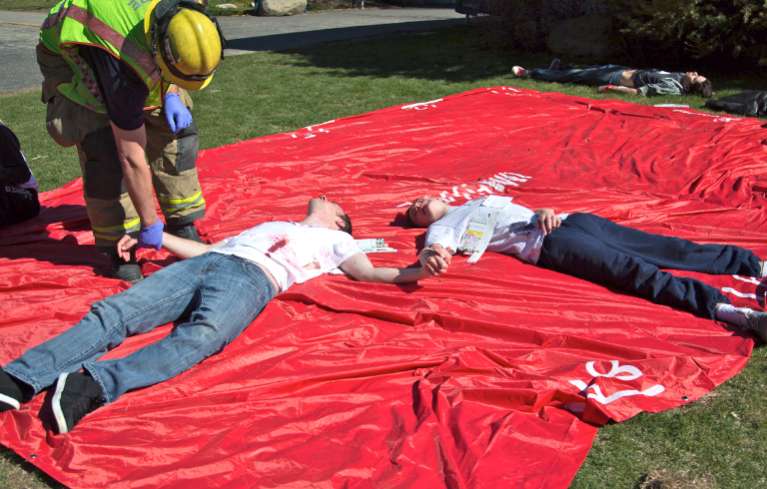Drill keeps first responders’ skills sharp

Emery Mulligan and Jack Suglian comfort each other after being “shot” April 7 at Tahoe Valley. Photos/Lesia Witkowsky
By Kathryn Reed
Shots have been fired at Tahoe Valley Elementary School. A guy has been seen with a gun. Sirens wail in the distance. Officers in helmets, some carrying AR-15 semi-automatic rifles make their way to the front of the building before entering. A shot goes off as they enter, but they proceed.
This was all a drill on Monday as members of the South Lake Tahoe fire and police departments practiced what they would do if there had been a shooting. They played out the same scenario a week ago at Lake Tahoe Community College, using the two facilities during their respective spring breaks. Lake Valley firefighters participated in last week’s training.
All the first responders knew is that the drill involved an active shooter. They didn’t know where he was, how many were wounded or the extent of their injuries.
Two members of Barton Health’s staff are there, too. Cate Neal is a trauma nurse coordinator and Tina Bruess is the grief counselor. They would be doing the same thing if this were real.
Ultimately it’s up to Barton to decide which patients go to what hospital.
Paramedics have the wounded – who are high school drama students – stretched out on green, yellow and red tarmacs. Red is for people with the severest wounds. The deceased are off to the side. The shooter, once apprehended, it kept far from his victims.
Some of the wounded have walked out on their own; rescue personnel assisted others. The paramedics assess their condition, putting a triage tag around their neck so once they get to the hospital the medical personnel will have some idea of what they are dealing with.
Gone are the days when the wounded are tended to after the shooter is in custody or killed. The old policy had victims waiting hours to receive medical care.
“We make it as safe as we can and then get people inside help,” police Lt. David Stevenson told Lake Tahoe News.
While the scenario had nowhere near the intensity of a real tragedy, it still provides those involved with an opportunity to get a feel for what it would be like.
“Our mass casualty incident training days provided us excellent training opportunities to work on our skills in responding to an incident with multiple victims. These events can be very challenging for responders due to the complexity of the required steps to triage, treat and transport multiple patients,” Kim George, SLTFD engineer, told Lake Tahoe News. She coordinated the event. “This live drill training provides us all with a memory to call upon if we encounter a true incident that is similar in nature and that gives us an advantage.”
Douglas County loaned the city its camera that was posted high in the air to capture what was going on. This was being relayed back to Lake Tahoe Airport, which doubles as the command post for the Office of Emergency Services, where Fire Chief Jeff Meston was watching his charges.
With mass shootings happening throughout the country, and close by – Carson City iHop in 2011 – this type of scenario could be a reality in South Lake Tahoe. The closest school shooting was last year at Sparks Middle School where a student killed a teacher before shooting himself.
Mother Jones has been tracking mass shootings. There have been 67 mass shootings in the last three decades. Most shooters got their weapons legally.
(Click on photos to enlarge.)







